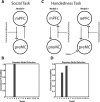Seeing the Unexpected: How Brains Read Communicative Intent through Kinematics
- PMID: 31504305
- PMCID: PMC7132920
- DOI: 10.1093/cercor/bhz148
Seeing the Unexpected: How Brains Read Communicative Intent through Kinematics
Abstract
Social interaction requires us to recognize subtle cues in behavior, such as kinematic differences in actions and gestures produced with different social intentions. Neuroscientific studies indicate that the putative mirror neuron system (pMNS) in the premotor cortex and mentalizing system (MS) in the medial prefrontal cortex support inferences about contextually unusual actions. However, little is known regarding the brain dynamics of these systems when viewing communicatively exaggerated kinematics. In an event-related functional magnetic resonance imaging experiment, 28 participants viewed stick-light videos of pantomime gestures, recorded in a previous study, which contained varying degrees of communicative exaggeration. Participants made either social or nonsocial classifications of the videos. Using participant responses and pantomime kinematics, we modeled the probability of each video being classified as communicative. Interregion connectivity and activity were modulated by kinematic exaggeration, depending on the task. In the Social Task, communicativeness of the gesture increased activation of several pMNS and MS regions and modulated top-down coupling from the MS to the pMNS, but engagement of the pMNS and MS was not found in the nonsocial task. Our results suggest that expectation violations can be a key cue for inferring communicative intention, extending previous findings from wholly unexpected actions to more subtle social signaling.
Keywords: communication; connectivity; fMRI; gesture; intention.
© The Author(s) 2019. Published by Oxford University Press.
Figures




Similar articles
-
Differential role of the Mentalizing and the Mirror Neuron system in the imitation of communicative gestures.Neuroimage. 2013 Nov 1;81:294-305. doi: 10.1016/j.neuroimage.2013.05.021. Epub 2013 May 17. Neuroimage. 2013. PMID: 23684882
-
Communicative intent modulates production and comprehension of actions and gestures: A Kinect study.Cognition. 2018 Nov;180:38-51. doi: 10.1016/j.cognition.2018.04.003. Epub 2018 Jul 5. Cognition. 2018. PMID: 29981967
-
Differences in the production and perception of communicative kinematics in autism.Autism Res. 2021 Dec;14(12):2640-2653. doi: 10.1002/aur.2611. Epub 2021 Sep 18. Autism Res. 2021. PMID: 34536063 Free PMC article.
-
The neural basis of hand gesture comprehension: A meta-analysis of functional magnetic resonance imaging studies.Neurosci Biobehav Rev. 2015 Oct;57:88-104. doi: 10.1016/j.neubiorev.2015.08.006. Epub 2015 Aug 10. Neurosci Biobehav Rev. 2015. PMID: 26271719 Review.
-
The body talks: Sensorimotor communication and its brain and kinematic signatures.Phys Life Rev. 2019 Mar;28:1-21. doi: 10.1016/j.plrev.2018.06.014. Epub 2018 Jun 30. Phys Life Rev. 2019. PMID: 30072239 Review.
Cited by
-
Interactionally Embedded Gestalt Principles of Multimodal Human Communication.Perspect Psychol Sci. 2023 Sep;18(5):1136-1159. doi: 10.1177/17456916221141422. Epub 2023 Jan 12. Perspect Psychol Sci. 2023. PMID: 36634318 Free PMC article. Review.
-
Differences in functional brain organization during gesture recognition between autistic and neurotypical individuals.Soc Cogn Affect Neurosci. 2022 Nov 2;17(11):1021-1034. doi: 10.1093/scan/nsac026. Soc Cogn Affect Neurosci. 2022. PMID: 35428885 Free PMC article.
-
Reading out bodily cues to predict interactions.Sci Rep. 2025 May 29;15(1):18865. doi: 10.1038/s41598-025-01224-7. Sci Rep. 2025. PMID: 40442134 Free PMC article.
-
Hierarchical Integration of Communicative and Spatial Perspective-Taking Demands in Sensorimotor Control of Referential Pointing.Cogn Sci. 2022 Jan;46(1):e13084. doi: 10.1111/cogs.13084. Cogn Sci. 2022. PMID: 35066907 Free PMC article.
-
People infer communicative action through an expectation for efficient communication.Nat Commun. 2022 Jul 18;13(1):4160. doi: 10.1038/s41467-022-31716-3. Nat Commun. 2022. PMID: 35851397 Free PMC article.
References
-
- Bates D, Mächler M, Bolker B, Walker S. 2014. Fitting linear mixed-effects models using lme4. J Stat Softw. 67:1–48.
-
- Becchio C, Koul A, Ansuini C, Bertone C, Cavallo A. 2018. Seeing mental states: an experimental strategy for measuring the observability of other minds. Phys Life Rev. 24:67–80. - PubMed
-
- Blakemore S, Decety J, Albert C. 2001. From the perception of action to the understanding of intention. Nat Rev Neurosci. 2(8):561–567. - PubMed
Publication types
MeSH terms
LinkOut - more resources
Full Text Sources

